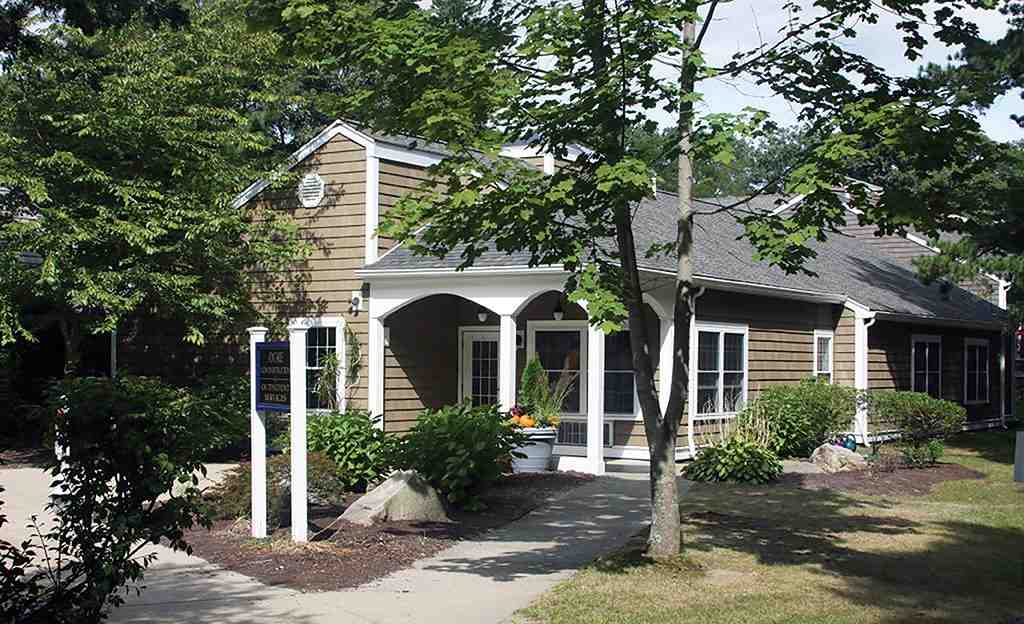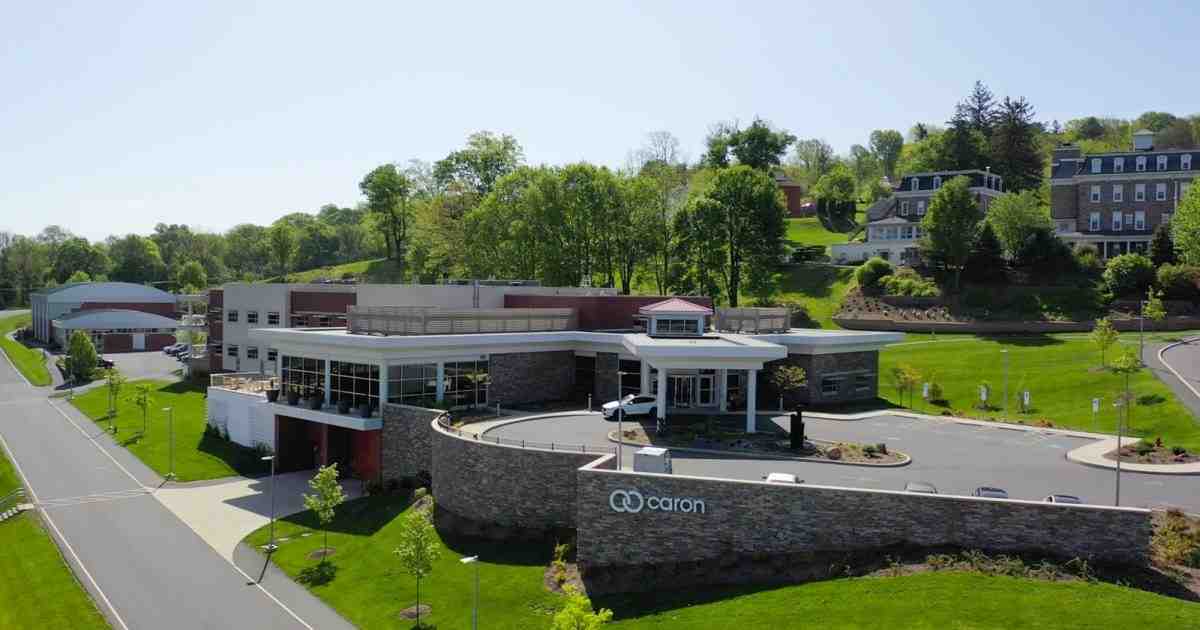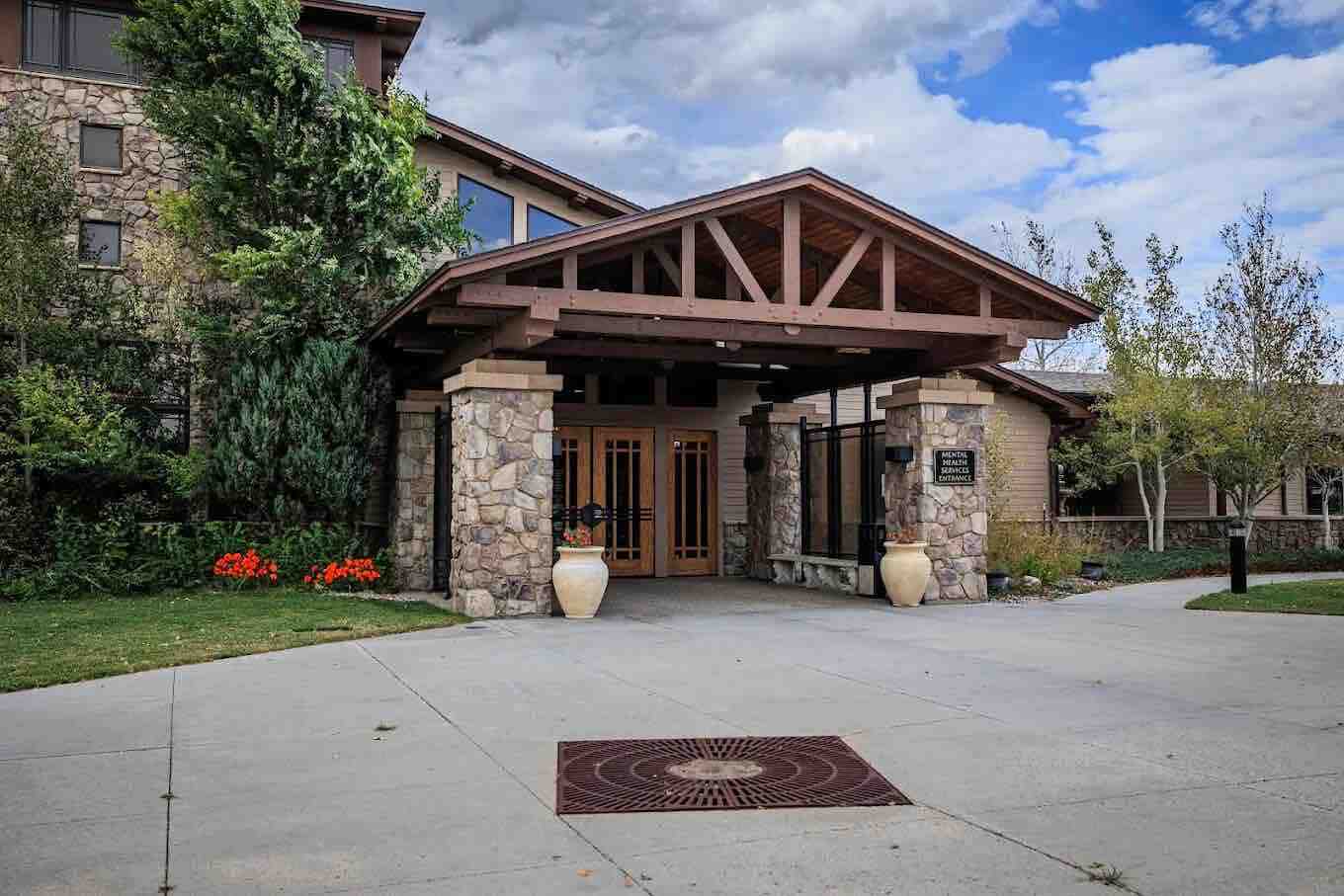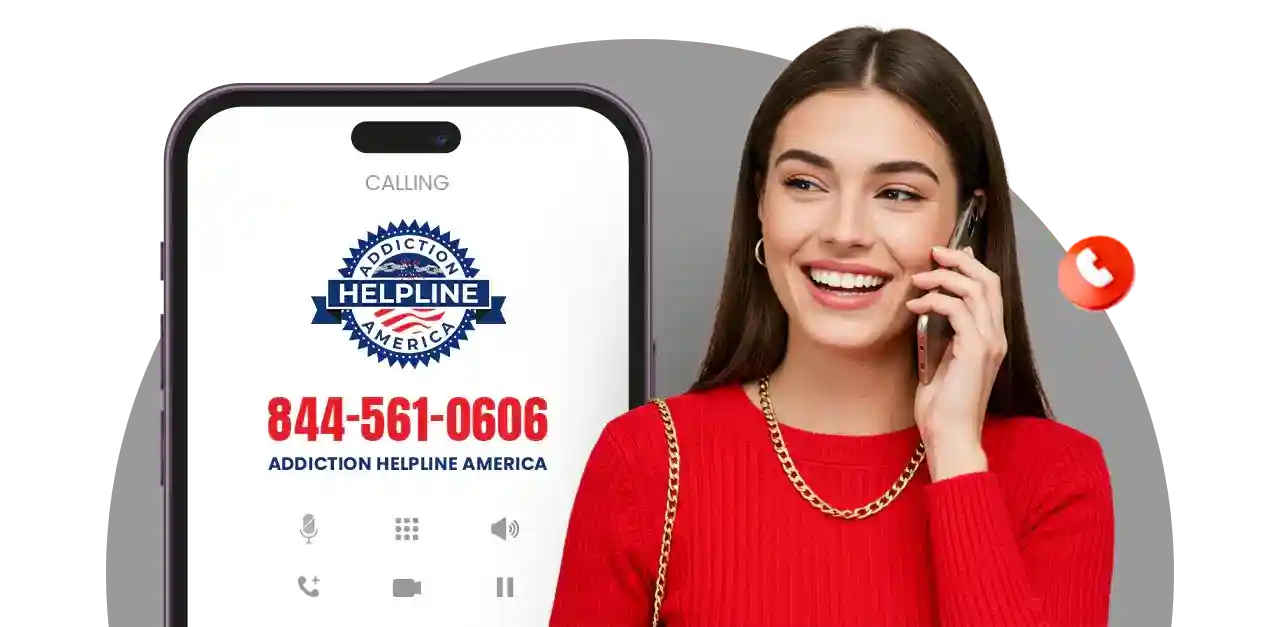
Understanding Your Path to Recovery
Drug treatment options are services designed to help individuals overcome substance use disorders (SUDs). Addiction is a treatable chronic health condition, much like diabetes or heart disease, and effective, evidence-based treatments exist. Available services include:
- Detoxification: Medical supervision during withdrawal.
- Outpatient Programs (OP): Flexible care (up to 9 hours/week).
- Intensive Outpatient (IOP): Structured support (10-20 hours/week).
- Partial Hospitalization (PHP): Day treatment (20+ hours/week).
- Residential/Inpatient Treatment: 24/7 supervised care (30-90+ days).
- Medication-Assisted Treatment (MAT): FDA-approved medications with counseling.
- Behavioral Therapy: Evidence-based counseling like CBT and group therapy.
- Continuing Care: Ongoing support, including sober living and support groups.
Many people mistakenly believe “treatment” is just detox or a 30-day rehab program. In reality, detox only manages physical withdrawal; it is not a cure. True recovery requires a personalized plan addressing the physical, psychological, and social aspects of addiction.
At Addiction Helpline America, our specialists connect individuals with the right drug treatment options for their unique situations, guiding them from assessment to long-term support.
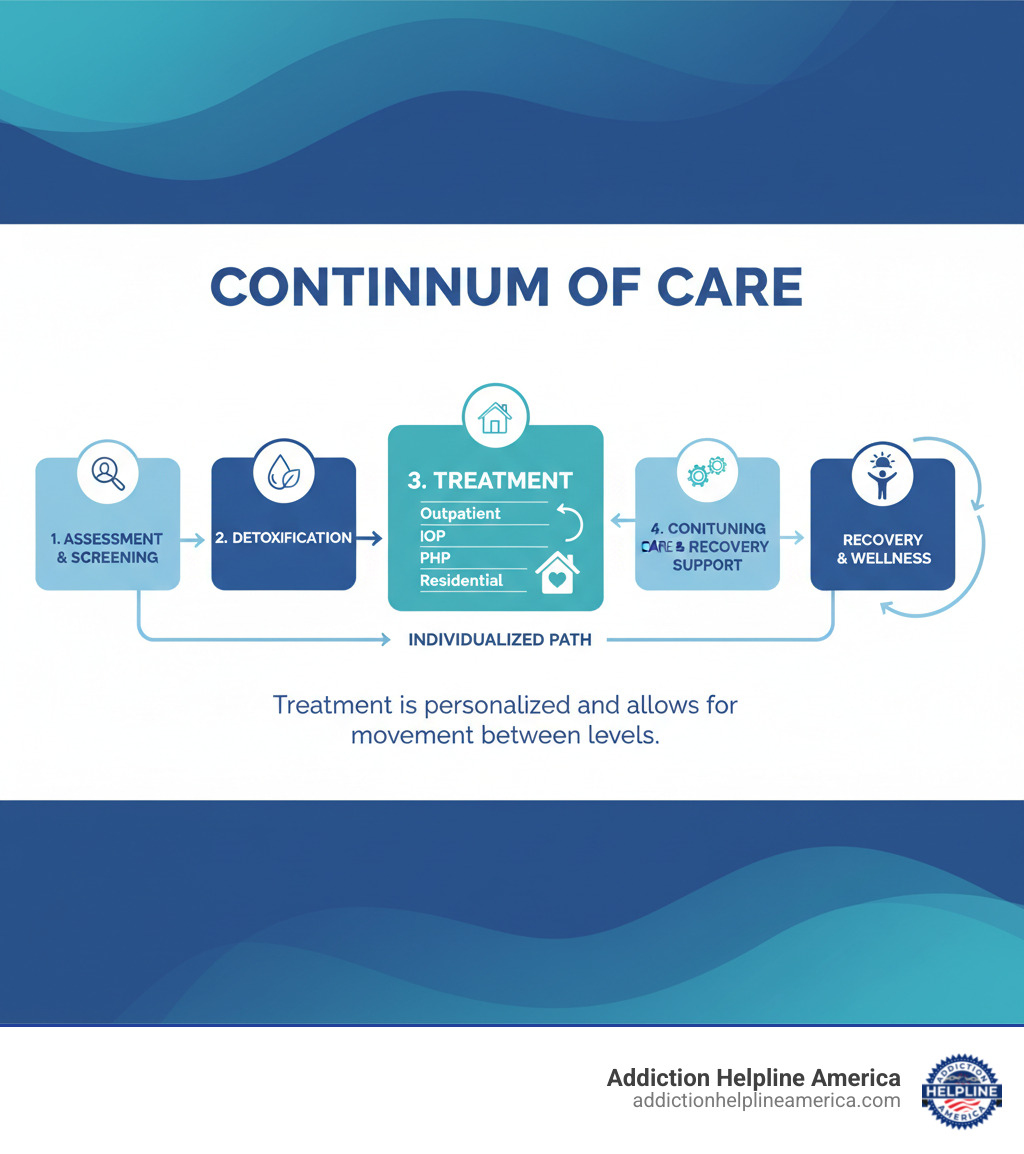
Simple guide to Drug treatment options:
The First Step: Understanding Detoxification and Assessment
Seeking help for a substance use disorder begins with withdrawal management, or “detox.” Detox is not treatment itself but an essential first step. During detox, the body eliminates the substance, which can be uncomfortable and even dangerous. For this reason, medical supervision is vital to ensure safety and manage discomfort. We never recommend attempting to detox alone at home.
Following detox, a thorough initial assessment is conducted to understand you as a whole person. This includes a psychological evaluation to identify co-occurring conditions like depression or anxiety and a physical health screening to address any related medical issues. This comprehensive evaluation helps determine the most effective drug treatment options for your situation.
Approaches to Withdrawal Management
The method for managing withdrawal depends on the substance used. There is no one-size-fits-all approach.
-
Medical detox provides 24/7 medical care, which is essential for substances like alcohol, benzodiazepines, and opioids, where withdrawal can be severe or life-threatening. Medications are used to ease symptoms and prevent complications.
-
Social model detox offers a supportive, peer-based environment with counseling for those whose withdrawal is not medically complex.
-
Tapering involves gradually reducing the substance dose under medical guidance to minimize withdrawal symptoms.
Different substances require specific protocols:
-
Opioid withdrawal is unpleasant but rarely life-threatening. Medications like buprenorphine or methadone manage symptoms and are often continued in long-term Medication-Assisted Treatment (MAT).
-
Alcohol withdrawal can be dangerous, potentially causing seizures or delirium tremens (DTs). Medical detox, often using benzodiazepines, is critical for safety. Never attempt to detox from heavy, long-term alcohol use on your own.
-
Benzodiazepine withdrawal carries similar risks to alcohol and requires a slow, medically supervised taper to prevent seizures.
-
Stimulant withdrawal (from cocaine, methamphetamine) is not typically medically dangerous but involves intense cravings, fatigue, and severe depression. Treatment focuses on supportive care and managing psychological symptoms.
At Addiction Helpline America, we connect you with the appropriate level of withdrawal management, guiding you toward safe, compassionate care to set you up for successful recovery.
The Core of Recovery: A Spectrum of Drug Treatment Options
After detox and assessment, the real work of recovery begins. Drug treatment options address the psychological, emotional, and social factors of addiction. Treatment is not one-size-fits-all; it exists on a spectrum of intensity. Professionals use criteria from the American Society of Addiction Medicine (ASAM) to match you with the appropriate level of care, balancing support and independence.
At Addiction Helpline America, we help people steer these options to find their path forward.

Outpatient Programs (OP)
Ideal for mild substance use disorders and those with a stable, supportive home life, outpatient programs offer flexibility. Treatment is typically nine hours or less per week, scheduled around work or school. OP includes group and individual therapy, allowing you to apply recovery principles to your daily life. This model works best for highly motivated individuals who do not require 24/7 supervision.
Intensive Outpatient (IOP) & Partial Hospitalization (PHP)
For those needing more support than OP but not 24/7 care, IOP and PHP are excellent options.
-
IOPs provide 10-20 hours of treatment per week, serving as a step-down from residential care or a starting point for those needing more than weekly therapy.
-
PHPs (day treatment) are more intensive, with 20 or more hours of treatment per week. You participate in structured therapy during the day and return home at night. PHP is useful for those who need comprehensive support and monitoring but have a stable home environment.
Both options allow you to build recovery skills in a structured setting while staying connected to your community.
Residential and Inpatient Treatment
For moderate to severe substance use disorders, or when the home environment is unsafe, residential and inpatient treatment offers the highest level of care. These programs provide 24/7 supervised support in a structured setting, typically for 30, 60, or 90 days. Living at the facility removes you from triggers and allows you to focus entirely on healing. This level of care is often recommended for those with co-occurring mental health conditions or who have been unsuccessful in less intensive programs.
| Treatment Level | Intensity | Time Commitment | Ideal Candidate |
|---|---|---|---|
| Outpatient (OP) | Low | Up to 9 hours/week | Mild SUD, strong home support, stable life, highly motivated. |
| Intensive Outpatient (IOP) | Moderate | 10-20 hours/week | Moderate SUD, step-down from residential, needs significant support but can live at home. |
| Partial Hospitalization (PHP) | High | 20+ hours/week (daytime) | Moderate to severe SUD, needs medical monitoring/structured days, but can return home evenings. |
| Residential/Inpatient | Very High (24/7) | 30 days to over a year | Severe SUD, unstable home environment, co-occurring disorders, needs complete removal from triggers, requires constant supervision. |
A professional assessment is crucial for determining the right level of care. Our team at Addiction Helpline America can help you understand these drug treatment options and connect you with a program that matches your needs.
Key Components of Effective Treatment Programs
Effective drug treatment options use a whole-person approach, addressing every aspect of life affected by addiction. At Addiction Helpline America, we connect you with programs that use evidence-based practices proven by scientific research. Your treatment plan will be individualized, because your path to recovery is unique.
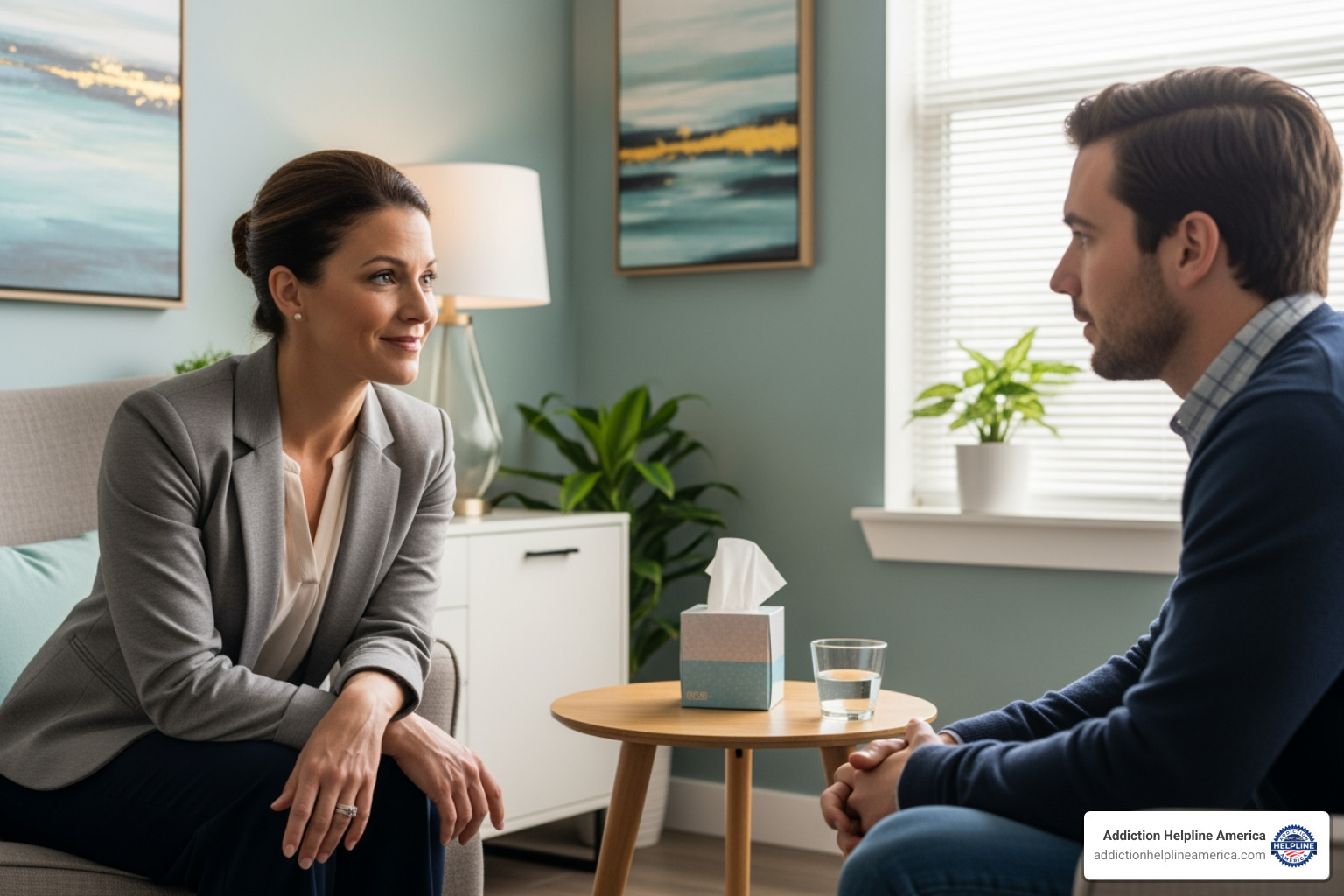
The Role of Behavioral Therapy in Addiction Treatment
Behavioral therapy is where you learn why you use substances and develop tools to change those patterns. A licensed professional helps you modify behaviors and learn to handle triggers. Key approaches include:
- Cognitive-Behavioral Therapy (CBT): Helps you identify and correct problematic behaviors by learning to recognize and cope with high-risk situations.
- Motivational Improvement Therapy (MET): Helps resolve ambivalence about treatment and builds internal motivation to change.
- Contingency Management: Uses tangible rewards (vouchers, small incentives) for remaining drug-free, which is particularly effective for stimulant use disorder.
These therapies are essential for developing coping skills and form the backbone of relapse prevention. For more information, see the Principles of Drug Addiction Treatment: A Research-Based Guide.
Integrated Services for Holistic Recovery
Comprehensive treatment includes multiple layers of support:
- Individual and Group Counseling: Provide a confidential space for personal issues and the power of shared experience, respectively.
- Family Therapy: Repairs damaged relationships, improves communication, and is essential for adolescent treatment.
- Addiction Education: Teaches the science of addiction to remove shame and build a relapse prevention toolkit.
- Life Skills and Vocational Services: Help you rebuild a stable life through budgeting, job searching, and stress management, which are crucial for long-term recovery.
- Mental Health Services: Are integrated with addiction treatment to address co-occurring issues.
Treating Co-Occurring Disorders (Dual Diagnosis)
About half of people with a substance use disorder also have a co-occurring mental illness, known as a “dual diagnosis.” Common conditions include anxiety, depression, post-traumatic stress disorder (PTSD), and bipolar disorder. Using substances to self-medicate these conditions is common.
The key is integrated treatment, where both the SUD and mental health condition are addressed simultaneously by a coordinated team. Treating one without the other is ineffective. We connect you with programs that treat you as a whole person, offering a real path to healing. For 24/7 help, call the SAMHSA National Helpline for free, confidential assistance.
Medication-Assisted Treatment (MAT)
Medication-Assisted Treatment (MAT) combines FDA-approved medications with counseling and behavioral therapies. This approach is proven to be helpful for physical dependency on substances like alcohol, nicotine, and opioids. The medications work by reducing cravings, preventing relapse, and helping to normalize brain chemistry. This is not about replacing one drug with another; it’s about using medical science to support recovery. When brain chemistry is stabilized, you can better engage in therapy and develop coping skills for lasting change.

Specific Drug Treatment Options for Opioid Use Disorder
For opioid use disorder (OUD), MAT is the gold standard of treatment. Medications like methadone, buprenorphine, and naltrexone are the first line of treatment, significantly reducing the risk of overdose.
- Methadone: A long-acting medication dispensed at specialized clinics that reduces cravings and withdrawal without producing a high.
- Buprenorphine (e.g., Suboxone): Works similarly but can be prescribed in an office setting. It has a “ceiling effect,” making it safer and less likely to be misused.
- Naltrexone (e.g., Vivitrol): Blocks the euphoric effects of opioids, preventing a high if relapse occurs. It is non-addictive and available as a daily pill or monthly injection.
Addiction Helpline America can help you find programs offering these proven drug treatment options.
Medications for Alcohol and Other Substance Use Disorders
MAT is also effective for alcohol use disorder (AUD). Three FDA-approved medications are available:
- Acamprosate: Reduces alcohol cravings after you’ve stopped drinking.
- Disulfiram: Causes unpleasant physical reactions if you drink alcohol, acting as a deterrent.
- Naltrexone: Reduces cravings and the pleasurable effects of alcohol.
For stimulant use disorders (cocaine, methamphetamine), there are currently no FDA-approved medications. However, behavioral therapies like Contingency Management have proven highly effective. Emerging research continues to explore new pharmacological options, offering new hope for those affected by SUDs.
Life After Treatment: Continuing Care and Support
Completing a treatment program is a major achievement, but recovery is a journey, not a destination. Ongoing support is essential to prevent relapse, much like managing a chronic illness like diabetes. Building a strong support network and applying the skills learned in treatment are key to long-term success.
It’s important to know that relapse is not failure. It is a common part of the recovery journey and indicates that a treatment plan may need adjustment. It’s an opportunity to learn about triggers and strengthen coping strategies. The key is to get back on track quickly without shame or isolation.
Continuing Care and Aftercare Plans
An effective treatment program includes a solid aftercare plan—a personalized relapse prevention strategy to support your transition back to daily life. This may include regular check-ins with a therapist, alumni programs, and ongoing individual or group counseling. Integrating this support system into your routine is critical for sustained recovery. At Addiction Helpline America, we help you find programs that prioritize comprehensive aftercare planning.
Recovery Residences and Sober Living Homes
Recovery residences, or sober living homes, provide a supportive, substance-free environment that bridges the gap between residential treatment and independent living. You live with peers in recovery, which provides built-in support and accountability. Most homes have rules, require participation in recovery activities, and expect residents to work or attend school. This structured setting allows you to practice recovery skills in the real world with a safety net.
Mutual Support Groups
Mutual support groups offer a community of peers who provide encouragement, understanding, and accountability, often for free.
-
The best-known are 12-Step programs like Alcoholics Anonymous (AA) and Narcotics Anonymous (NA), which use a structured set of guiding principles.
-
Non-12-Step alternatives like SMART Recovery (Self-Management and Recovery Training) use cognitive-behavioral principles and focus on self-empowerment.
These groups are highly accessible, with meetings available in person and online. Finding a supportive community, whether through 12-Step, non-12-Step, or therapy, dramatically increases your chances of long-term success with your chosen drug treatment options.
Finding Help: Specialized Programs and Vital Resources
Navigating drug treatment options can feel overwhelming, but specialized programs exist for nearly every circumstance, and accessing them is more straightforward than you might think.
Specialized Drug Treatment Options
Effective treatment recognizes that different people face different challenges.
- Perinatal programs for pregnant and parenting women offer evidence-based care focusing on the health of both mother and child.
- Adolescent-specific treatment addresses the unique needs of young people, often incorporating family therapy and academic support. The Principles of Adolescent Substance Use Disorder Treatment provides valuable insights.
- Court-referred programs like drug courts offer treatment as an alternative to incarceration.
- Programs for veterans address the intersection of substance use and service-related conditions like PTSD.
Overdose Prevention and Legal Protections
Overdose prevention can save a life. Naloxone (Narcan) is a medication that can temporarily reverse an opioid overdose, providing time to get medical help. It is available as a nasal spray, and many communities offer it for free with training.
Additionally, Good Samaritan Laws provide legal protection from arrest for minor drug offenses for those who call 911 during an overdose. For example, California’s 911 Good Samaritan Law (AB 472) encourages people to seek help without fear. Knowing your state’s laws can empower you to act quickly and save a life.
How to Access Treatment Services
You don’t have to do this alone. Help is a phone call or click away.
-
National Helplines: The 988 Suicide & Crisis Lifeline (call or text 988) offers immediate crisis support. For treatment referrals, SAMHSA’s National Helpline (1-800-662-HELP) provides free, confidential information 24/7. You can also use SAMHSA’s Find Help service.
-
Online Treatment Locators: SAMHSA’s FindTreatment.gov is a confidential tool for locating treatment facilities across the U.S.
-
Insurance and Payment: At Addiction Helpline America, we can help you verify your insurance benefits, explore costs, and identify free or low-cost options. Our team cuts through the confusion so you can focus on getting well.
Frequently Asked Questions about Drug Treatment
Considering treatment is a courageous step. Here are answers to some of the most common questions we hear.
How do I know which level of care is right for me?
This is a question best answered with professional guidance. The right level of care depends on the severity of your substance use, your physical and mental health, and your home environment. A professional assessment by a doctor or licensed counselor is the best way to determine the appropriate placement. They use standardized criteria to recommend drug treatment options that match your specific needs. At Addiction Helpline America, our specialists can connect you with professionals to conduct this vital assessment.
Does relapse mean treatment has failed?
No, absolutely not. Addiction is a chronic illness. Like with diabetes or asthma, a recurrence of symptoms (relapse) does not mean treatment has failed. It is a sign that the treatment plan may need to be adjusted. A relapse is an opportunity to reassess coping strategies and strengthen your recovery. Many people who experience relapse go on to achieve long-term sobriety by learning from the experience.
What is the difference between detoxification and addiction treatment?
This is a critical distinction. Detoxification (detox) is the process of safely managing the acute physical symptoms of withdrawal. It is medical stabilization and the necessary first step, but it is not treatment itself.
Comprehensive addiction treatment begins after detox. It addresses the underlying psychological, social, and behavioral issues that contribute to substance use. Treatment involves therapy, counseling, and skill-building to create lasting change. Completing detox without follow-up treatment often leads to relapse because the root causes of the addiction have not been addressed. This is why comprehensive drug treatment options are essential for long-term recovery.
Conclusion
Understanding your drug treatment options is the first step on the path to recovery. This journey is not about reaching a finish line but about continuous growth and refinding yourself beyond addiction.
While the landscape of treatment—from detox to aftercare—can seem complex, you don’t have to steer it alone. Every person’s path is different, and there is no single “right” way to recover, only your way. Whether you need residential care, an outpatient program, or medication-assisted treatment, the right support is available.
Hope and healing are achievable. With personalized care and a willingness to take the first step, you can build the life you deserve.
At Addiction Helpline America, we connect people nationwide to addiction and mental health treatment centers every day. We offer free, confidential guidance to help you understand your options and find a program that fits your needs. No judgment, just support.
Take the first step towards a healthier future today.
Our helpline is 100%
free & confidential
If you or someone you care about is struggling with drug or alcohol addiction, we can help you explore your recovery options. Don’t face this challenge alone—seek support from us.
Programs
Resources
Will my insurance
cover addiction
treatment?
We're ready to help
Find the best
drug or alcohol treatment
center
Are you or a loved one struggling with addiction? Call today to speak to a treatment expert.




